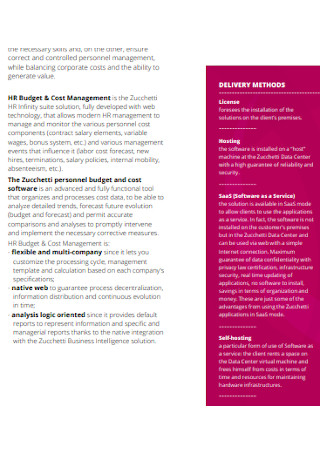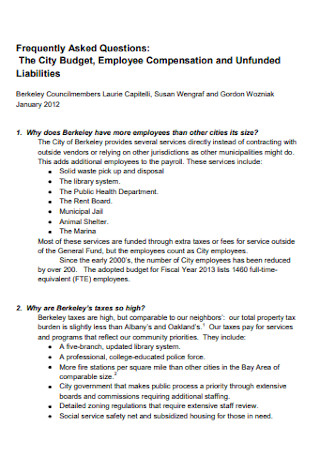32+ Sample HR Budgets
-

Human Resources Budget Template
download now -

HR Financial Budget
download now -

Sample HR Request Budget
download now -

HR Employee Travel Budget
download now -

Human Resources Expenditures Budget
download now -

Employee Retirement Budget Worksheet
download now -

Corporate HR Budget
download now -

HR Payroll Budget
download now -

Basic HR Salary Budget
download now -

Human Resources Budget Format
download now -

HR Cost Management Budget
download now -

Employee Mobility Budget Template
download now -

HR Finance Budget Template
download now -

Employee Work Pre-Budget
download now -

Standard Salary Budget Template
download now -

Recreation Employees Payroll Budget
download now -

Sample Office HR Budget
download now -

Formal Employee Budget Template
download now -

Public and Employee Budget
download now -

HR Service Budget Template
download now -

Human Resources Budget Report
download now -

Office Employee Budget Template
download now -

Mincipal Employee Budget Template
download now -

Employee House Budget Template
download now -

Employee Payroll And Training Budget
download now -

HR Fund Budget Template
download now -

HR Annual Budget Template
download now -

Employee Spending Budget Template
download now -

Employee Payroll Budget Template
download now -

Employee Mobility Budget Template
download now -

Employee Mobility Budget Template
download now -

Employee Assistance Program Budget
download now
What Is an HR Budget?
If you are unfamiliar with the term or need a refresher, an HR budget allocates funds specifically for all human resource processes within an organization. Since the most valuable asset of a business is its employees, this budget must be meticulously planned, communicated to the leadership team, and approved by them. There are two categories of HR budgets organizations generally use. Some variables, including available funds, projected expenses, and projected profits, determine the type you select. How can you be positive to include everything in an HR budget, given that human resources encompasses numerous areas? Even a small business can underestimate the costs of recruitment, hiring, training, and other measures to provide a wonderful experience for employees. As we saw during the pandemic, it is also a factor that can cause internal and external discord within an organization virtually overnight.
Benefits of an HR Budget
The value of budgeting for human resources cannot be overstated. Ensuring your organization has adequate funding enables you to recruit and have a talented and diverse workforce. The following is how HR budget planning can benefit HR activities:
Tips to Consider for Your Next HR Budget
Human resources have changed dramatically in the two years since the advent of remote work. Consequently, the modern HR professional is viewed as a contributor to the organization’s value. In 2022, the top priority of every modern business was to provide an exceptional employee experience to retain star employees in the talent war and improve their brand reputation. Every modern HR professional should be aware of several fundamental considerations when constructing a new HR budget plan. If you are still intrigued, here are some budgeting tips for human resources.
1. Employee Wellbeing
Eighty percent of American workers reported that their occupations are stressful. Nearly half of them indicated they require assistance to enhance their overall well-being. Employee wellness, on the other hand, lies somewhere between the bottom and middle of the list. During the economic slump in 2020, some companies were compelled to cut back on their employee benefits. This has harmed employee retention and morale. Leaders in human resources must prioritize implementing initiatives that improve employee health and performance. This is essential for retaining employees during such difficult circumstances.
2. Recognition and Rewards
Manual rewards and recognition letters, such as routine performance evaluations, could be more efficient, more efficient, and prone to human error. In addition, they’re also challenging to implement in a remote-first culture. Instead, performance incentives should be immediate and automated. Furthermore, HR departments are tasked with several essential responsibilities, including employee engagement and recognition. With ever-increasing duties and limited resources, it can take time to engage with employees personally. The HR department should budget for a solution enabling automated yet meaningful employee appreciation.
3. Workforce Shaping
At present, the human resources industry is dominated by automation. You will see an automatically generated job list when you visit a job portal. Typically, a resume parser or applicant tracking system (ATS) populates the job application with the applicant’s resume and cover letter for recruitment purposes. Automation not only saves time but also a substantial amount of money. However, the eventual need for workforce shaping is a significant disruption brought on by HR automation. The process of redefining employee roles and responsibilities to satisfy the demands of a digitally transformed workplace is workforce shaping.
4. Reconstruct and Reskill the Workforce for Tomorrow
Digital transformation is not limited to technology alone. HR departments must be adaptable and technologically adept. They must assist their enterprises in reorganizing to become more efficient. Due to digital transformation, human resource management, performance management, leadership, and recruitment plan must be rethought and rewritten. However, it is essential to consider that implementing these new ideas will require a substantial amount of time and resources. Therefore, you must be extremely specific about what you want and describe how others will benefit.
5. Rapid Turnover Rates
The Great Resignation, fueled by firms offering remote work, caused 4 million Americans to quit in July 2021, according to the U.S. Bureau of Labor Statistics. Better remote opportunities will keep employee turnover high. HR should consider the cost of replacing those workers and retraining the new staff. Thus, staff data is recommended for talent tracking and sourcing.
How to Prepare an HR Budget
If you don’t have a plan, making a budget for HR can be challenging. Getting accurate estimates of what will be spent in the future is a common problem in HR budgeting. In an HR department, estimating costs can take a lot of work. Salaries must be accounted for at the beginning, reviewed mid-period, and evaluated at the end. Here’s what HR managers can do to make an HR Budget:
1. Analyze Historical Performance and Predict Future Costs
The first step in preparing an adequate HR budget is gathering historical data and analyzing past performance. Analyze and identify the primary improvement areas. The following stage is to determine where the funds will be spent. This could include any combination of salary and benefits, training, facilities, and equipment report. With the assistance of an HR audit, analyzing past performance can also be simplified.
2. Evaluate Organizational Priorities and Requirements
After determining where the money will be spent, consider the funding’s specific objective. Does the expenditure guarantee high levels of personnel with continuous expansion? Or can the funds be allocated to initiatives that will benefit your organization in the long run? Understanding the organization’s requirements and priorities will simplify the budgeting process.
3. Determine the Optimal Funding Allocation
With the proper allocation of funds, you can provide your employees with benefits and other incentives. A common HR budgeting objective is to allocate funds to maximize their strategic value. You must understand how to spend your HR budget wisely. It is essential to understand the costs associated with your business. Before establishing the optimal allocation of funds, you should also know how they affect different departments. The quantity of money you allocate for employee salaries will vary based on the size and nature of your organization.
4. Propose Necessary Modifications as Required
The budget for HR should be different. Based on the company’s needs, the HR manager should be able to suggest changes to the budget. These changes reflect how the business world and the workforce are changing. The HR budget must also reflect the ability of an organization to compete in today’s economy. It should also be able to adjust to new situations. Many things can change how HR budgeting is done. Many companies have policies on how they conduct HR planning. These things can change how financial plans are set up. Some expenses may be inevitable under certain circumstances. Also, others may only be considered to improve employees’ efficiency and organizational effectiveness. Check to see if high costs should be addressed if you want to improve how well your employees do their jobs. If yes, include them in your HR budget.
FAQs
What are the HR costs?
Human resource expenses include recruiting, employing, training, and retaining personnel. Also included are the costs of employee benefits programs and other compensation-related expenditures. These expenses can vary significantly depending on the scale and scope of a business’s operations.
What should an HR budget include?
The human resources budget will include hiring, compensation, benefits, talent management action plan, training, succession planning, workforce engagement, and employee wellness planning. Every department’s financial information, performance report, and historical data are incorporated into HR budgets.
How are HR expenses calculated?
Depending on whether you include the organization’s workforce labor costs in HR expenses, HR costs can vary. Divide total HR expenses by total operating expenditures to calculate. Multiply the outcome by 100 to obtain the percentage.
The primary objective of HR budgeting is resource allocation within an organization. It ensures the organization accomplishes its mission and goals while minimizing ineffective or wasteful activities. With appropriate budgeting procedures, productivity and morale can increase among employees. Ultimately, it will lead to decreased productivity and an incapacity to perform their best.
